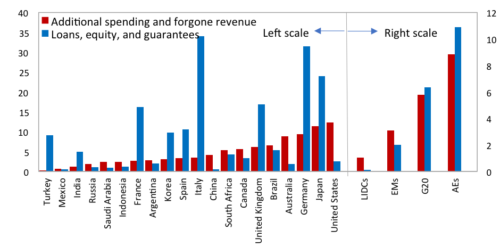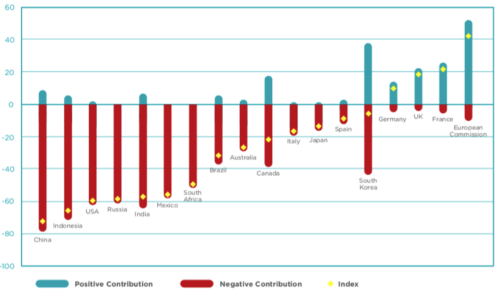IEEFA: Renewable energy must play a greater role in economic recovery from COVID-19
As the world grapples with the tragic health and economic consequences of COVID-19, governments have responded with a range of massive fiscal interventions. But while there is much talk of a ‘green recovery’, many governments are in fact prioritising environmentally unfriendly stimulus measures.
The Indian government needs to build in green recovery-oriented measures to deal with the current crisis and more importantly to prevent the climate crisis from impacting people’s health and livelihoods.
Fiscal Stimulus as a Share of GDP
As per the International Monetary Fund (IMF) Fiscal Monitor Database, discretionary stimulus spending as a share of GDP varies across different countries. The US leads the pack with 12.3% of GDP, followed by Japan and Germany with shares of 11.3% and 9.4% respectively. India has a significantly lower share, amounting to 1.2% of GDP.
Figure 1. Summary of Countries’ Fiscal Measures in Response to the COVID-19 Pandemic (% of GDP)
Green Stimulus?
With such large-scale government investment, there is a need to focus spending on plans that cut greenhouse gas emissions as well as boost the economy. The COVID-19 pandemic has amplified the call for stronger climate action to prevent the next human crisis.
The disparity in support between fossil and clean energy is particularly jarring given that renewables continue to out-perform fossil fuels on a cost basis
So, how much of the fiscal stimulus is going towards a green recovery? According to the Rhodium Group’s analysis of the IMF data, 20.2% of the European Union’s stimulus is focused on green, climate-related priorities, compared to only 1.1% of the US stimulus. India is spending just 2.4% of its stimulus on green energy.
Data by Vivid Economics reveals that across 17 major economies, out of the US$11.8 trillion global fiscal stimulus packages, around 30% (amounting to US$3.5 trillion) will flow into sectors that have intensive impacts on the environment—whether on climate change, biodiversity or local pollution.
Are countries doing enough to accelerate clean energy transitions? A glance at Vivid Economics’ Green Stimulus Index, which assesses the environmental orientation of stimulus funding in various countries, reveals recovery spending will have a net negative environmental impact in most of the countries. This is driven by the underlying policies supporting different fuels and energy types in the pre-COVID world.
Figure 2. Green Stimulus Index
As per the Energy Policy Tracker by the International Institute for Sustainable Development (IISD) and other organisations, as of 14 October G20 countries had committed over US$390 billion to supporting different energy types through new or amended policies, of which US$209 billion is supporting fossil fuel energy compared to US$145 billion supporting clean energy.
Within clean energy, US$51 billion are committed for ‘unconditionally’ clean investments. The remaining US$94 billion can support clean energy transition, but it is conditional upon sustainable implementation. France and the UK are the leading providers of unconditional support for clean energy, while the US and Germany are the top providers of conditional support.
According to the Tracker, India has committed at least US$23.3 billion to supporting different energy types, with US$9.86 billion towards supporting fossil fuel energy (US$2.12 billion to oil and gas and US$7.74 billion to coal). Further, US$12.1 billion support is provided to electricity distribution companies for making payments owed to generators. The only identified and quantified support for clean energy is US$1.3 billion, meagre in comparison to the funds allocated to fossil energy, which is for the supply of 9 hours of free solar power to farmers by the Andhra Pradesh state government.
Much of the global stimulus is going to industries and energy types with negative environmental impacts
The disparity in support between fossil and clean energy is particularly jarring given that renewables continue to out-perform fossil fuels on a cost basis—historically low renewable energy tariffs have been discovered in auctions in 2020, and global capital markets are rapidly moving away from fossil fuels, as their share prices hit new decade lows.
If India is going to back energy production, why invest in technology that is not only polluting but also less competitive?
Kick-Starting Green Recoveries
Much of the global stimulus is going to industries and energy types with negative environmental impacts. Instead of taking the opportunity to shift to clean energy, most countries are focusing COVID-19 economic recovery measures on sectors that contribute to environmental degradation.
Fatih Birol, Executive Director of the International Energy Agency (IEA), has urged countries to put clean energy at the heart of stimulus plans. Support measures, while protecting people and helping industries to cope with the crisis, must also combine environmental measures.
The ‘Next Generation EU’ recovery package amounting to US$830 billion is the most environmentally friendly stimulus package to date
And some countries are stepping up by implementing packages in which measures designed to support a green recovery make up a large proportion of their overall fiscal stimulus.
Germany’s stimulus – which Chancellor Angela Merkel described as a “package for the future” – in June 2020 amounting to US$45 billion was the first to provide substantial support to green measures. These include funding for green infrastructure and R&D, particularly in the energy and transport sectors, as well as some support for green agriculture and industry.
The ‘Next Generation EU’ recovery package amounting to US$830 billion is the most environmentally friendly stimulus package to date. Around 30% of this fund will be directed towards green initiatives such as reducing dependence on fossil fuels, enhancing energy efficiency and investing in preserving and restoring natural capital. In addition, all recovery loans and grants to member states will be attached to “do no harm” environmental safeguards.
The UK’s stimulus is a mixed bag with substantial support for green initiatives but also relaxing some environmental regulations and providing support to polluters. The UK government has provided support to wind energy and US$3.8 billion for energy efficiency improvements. In addition, there are small measures to support innovative R&D and contributions to the Green Jobs Challenge Fund.
Countries’ stimulus packages show that there are two paths to follow
France is the most successful at attaching green conditions to bailouts, introducing two major environmental conditions: the reduction of emissions by 50% and a minimum standard of 2% renewable fuel by 2030. The Minister of Transport recently stated that EUR 2 billion of France’s EUR 100 billion stimulus package will be blocked for clean cars, focused on electric and hybrid vehicles.
In July 2020, South Korea announced its ‘Green New Deal’ amounting to US$130 billion, which will support a variety of green projects and jobs over the next five years. It will include initiatives like renewable energy, electric and hydrogen vehicles, and energy efficiency in buildings.
Lessons for India
To tackle the economic slowdown and loss of jobs, the government is emphasising the need for India to become a self-reliant economy (‘AatmaNirbhar Bharat’). In order to meet its twin objectives of fueling economic growth and promoting domestic manufacturing, the government provides fiscal stimulus to clean energy including renewable energy, storage technologies and electric vehicles.
Other countries’ stimulus packages show that there are two paths to follow, and the future lies on the one less well travelled—that is, accelerating investments in clean energy. With this, the government can increase its revenue by expanding the manufacturing base for clean energy alternatives that will be in increasing demand internationally. This will also provide jobs growth in a sector that is more environmentally friendly and will not negatively impact the health of the people working in these areas.
At the same time, the government needs to accelerate the phasing out of inefficient older coal plants. Further, government needs to adhere to the 2022 timeline for adoption of environmental norms by the thermal power plants as they are one of the biggest contributors to local air pollution. UN Secretary General Antonio Guterres also emphasised that India needs to stop supporting fossil fuels and instead reap the benefits of renewable power.
India should kick-start a truly green future by embarking upon a green-oriented recovery, as Germany and France have done. The government is expected to announce recovery packages soon.
Vibhuti Garg, Energy Economist, IEEFA ([email protected])
Christopher Beaton, Lead, Sustainable Energy Consumption, IISD ([email protected])
Related links:
IEEFA: Wind-solar hybrid systems can power India’s next wave of renewables growth
IEEFA: India’s new green term-ahead market will boost trading of renewables
IEEFA: These 7 auctions show India’s renewables sector is still primed for growth

















